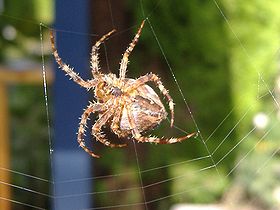

Spider silk is a protein fibre spun by spiders. Spiders use their silk to make webs or other structures, which function as nets to catch other animals, or as nests or cocoons for protection for their offspring. They can also suspend themselves using their silk.
Many small spiders use silk threads for ballooning, the scientific term for the dynamic kiting[1][2] spiderlings (mostly) use for dispersal. They extrude several threads into the air and let themselves become carried away with upward winds. Although most rides will end a few yards later, it seems to be a common way for spiders to invade islands. Many sailors have reported that spiders have been caught in their ship"s sails, even when far from land. The extremely fine silk used by spiders for ballooning is known as gossamer.[3]
In some cases, spiders may even use silk as a source of food.[4][5]
Methods have been developed to silk a spider forcibly.[6]
Properties
Spider silk is a remarkably strong material. Its tensile strength is comparable to that of high-grade steel (1500 MPa),[7][8] and about half as strong as aramid filaments, such as Twaron or Kevlar (3000 MPa).[9] Spider silk is about a fifth of the density of steel; a strand long enough to circle the Earth would weigh less than 500 grams (18 oz).[10]
Spider silk is also especially ductile, able to stretch up to 1.4 times its relaxed length without breaking; this gives it a very high toughness (or work to fracture), which "equals that of commercial polyaramid (aromatic nylon) filaments, which themselves are benchmarks of modern polymer fibre technology".[11][12] It can hold its strength below ?40 °C.
The strongest known spider silk is produced by the species Darwin"s bark spider (Caerostris darwini): "The toughness of forcibly silked fibers averages 350 MJ/m3, with some samples reaching 520 MJ/m3. ... Thus, C. darwini silk is more than twice as tough as any previously described silk, and over 10 times stronger than Kevlar."[13]
Types of silk
Many species of spider have different glands to produce silk with different properties for different purposes, including housing, web construction, defense, capturing and detaining prey, egg protection, and mobility (gossamer for ballooning, strands to let the spider drop down on as they are extruded). Different specialized silks have evolved with properties suitable for different uses. For example, Argiope argentata has five different types of silk, each used for a different purpose:[14][15]
| Silk | Use |
|---|---|
| dragline silk | Used for the web"s outer rim and spokes and the lifeline. As strong per unit weight as steel, but much tougher. |
| capture-spiral silk | Used for the capturing lines of the web. Sticky, extremely stretchy and tough. |
| tubiliform silk | Used for protective egg sacs. Stiffest silk. |
| aciniform silk | Used to wrap and secure freshly captured prey. Two to three times as tough as the other silks, including dragline. |
| minor-ampullate silk | Used for temporary scaffolding during web construction |
Composition
Spider silk is composed of complex protein molecules. This, coupled with the isolation stemming from the spider"s predatory nature, has made the study and replication of the substance quite challenging. Because of the repetitive nature of the DNA encoding the silk protein, it is difficult to determine its sequence and to date, silk-producing sequences have only been decoded for fourteen species of spider. In 2005, independent researchers in the University of Wyoming (Tian and Lewis), University of the Pacific (Hu and Vierra), the University of California at Riverside (Garb and Hayashi) and Shinshu University (Zhao and Nakagaki) have uncovered the molecular structure of the gene for the protein that various female spider species use to make their silken egg cases.
Although different species of spider, and different types of silk, have different protein sequences, a general trend in spider silk structure is a sequence of amino acids (usually alternating glycine and alanine, or alanine alone) that self-assemble into a beta sheet conformation. These "Ala rich" blocks are separated by segments of amino acids with bulky side-groups. The beta sheets stack to form crystals, whereas the other segments form amorphous domains. It is the interplay between the hard crystalline segments, and the strained elastic semi amorphous regions, that gives spider silk its extraordinary properties.[16] [17] The high toughness is due to the breaking of hydrogen bonds in these regions.
Various compounds other than protein are used to enhance the fiber"s properties. Pyrrolidine has hygroscopic properties and helps to keep the thread moist. It occurs in especially high concentration in glue threads. Potassium hydrogen phosphate releases protons in aqueous solution, resulting in a pH of about 4, making the silk acidic and thus protecting it from fungi and bacteria that would otherwise digest the protein. Potassium nitrate is believed to prevent the protein from denaturing in the acidic milieu.[18]
Biosynthesis
| This section requires expansion. |
The unspun silk dope is pulled through silk glands, resulting in a transition from stored gel to final solid fiber.
The gland"s visible, or external, part is termed the spinneret. Depending on the species, spiders will have two to eight spinnerets, usually in pairs. The beginning of the gland is rich in thiol and tyrosine groups. After this beginning process, the ampulla acts as a storage sac for the newly created fibers. From there, the spinning duct effectively removes water from the fiber and through fine channels also assists in its formation. Lipid secretions take place just at the end of the distal limb of the duct, and proceeds to the valve. The valve is believed to assist in rejoining broken fibers, acting much in the way of a helical pump.
The spinneret apparatus of a Araneus diadematus consists of the following glands:
- 500 Glandulae piriformes for attachment points
- 4 Glandulae ampullaceae for the web frame
- about 300 Glandulae aciniformes for the outer lining of egg sacs, and for ensnaring prey
- 4 Glandulae tubuliformes for egg sac silk
- 4 Glandulae aggregatae for glue
- 2 Glandulae coronatae for the thread of glue lines[18]
Human uses
Peasants in the southern Carpathian Mountains used to cut up tubes built by Atypus and cover wounds with the inner lining. It reportedly facilitated healing, and even connected with the skin. This is believed to be due to antiseptic properties of spider silk.[18]
Some fishermen in the Indo-Pacific ocean use the web of Nephila to catch small fish.[18]
The silk of Nephila clavipes has recently been used to help in mammalian neuronal regeneration.[19]
At one time, it was common to use spider silk as a thread for crosshairs in optical instruments such as telescopes, microscopes,[20] and telescopic rifle sights.[21]
Due to the difficulties in extracting and processing substantial amounts of spider silk, there is currently only one known piece of cloth made of spider silk, an 11-by-4-foot (3.4 by 1.2 m) textile with a golden tint made in Madagascar in 2009. 82 people worked for four years to collect over one million golden orb spiders and extract silk from them.[22]
Artificially produced spider silk
Spider silk is as strong as many industrial fibers (see tensile strength for common comparisons). There is commercial interest in duplicating spider silk artificially, since spiders use renewable materials as input and operate at room temperature, low pressures and using water as a solvent. However, it has been difficult to find a commercially viable process to mass-produce spider silk.
It is not possible to use spiders themselves to produce industrially useful quantities of spider silk, due to the difficulties of managing large quantities of spiders (although this was tried with Nephila silk[18]). Unlike silkworms, spiders eat one another, so that spiders cannot be kept together.
The properties of silk are determined both by its chemical composition and the mechanical process by which it is produced.
The spider"s highly sophisticated spinneret is instrumental in organizing the silk proteins into strong domains. The spinneret creates a gradient of protein concentration, pH, and pressure, which drive the protein solution through liquid crystalline phase transitions, ultimately generating the required silk structure, a mixture of crystalline and amorphous biopolymer regions. Replicating these complex conditions in a laboratory environment has proved difficult. Nexia used wet spinning and squeezed the silk protein solution through small extrusion holes in order to simulate the behavior of the spinneret, but this has so far not been sufficient to replicate the properties of native spider silk.[23]
One approach which does not involve farming spiders is to extract the spider silk gene and use other organisms to produce the spider silk. In 2000 Canadian biotechnology company Nexia successfully produced spider silk protein in transgenic goats which carried the gene for it; the milk produced by the goats contained significant quantities of the protein, 1–2 grams of silk proteins per liter of milk. Attempts to spin the protein into a fiber similar to natural spider silk resulted in fibers with tenacities of 2–3 grams per denier (see BioSteel).[24][25]
Extrusion of protein fibers in an aqueous environment is known as "wet-spinning". This process has so far produced silk fibers of diameters ranging from 10 to 60 ?m, compared to diameters of 2.5–4 ?m for natural spider silk.
The company Kraig Biocraft Laboratories[26] has used research from the Universities of Wyoming and Notre Dame in a collaborative effort to create a silkworm that is genetically altered to produce spider silk. In September 2010 it was announced at a press conference at the University of Notre Dame that the effort had been successful.[27]
In 2010, researchers from the Korea Advanced Institute of Science & Technology (KAIST) have succeeded in making spider silk directly with the bacteria E.coli, modified with certain genes of the spider Nephila clavipes. This thus eliminates dependency on the spider for milking and allows to manufacture the spider silk at a more cost-effective manner.[28]
See also
- Spider web
- Hagfish – produces similar fiber.
- Silk – natural fiber produced by silkworms, the larvae of the moth Bombyx mori.
- "The Silk Spinners", a BBC program about silk-producing animals.






